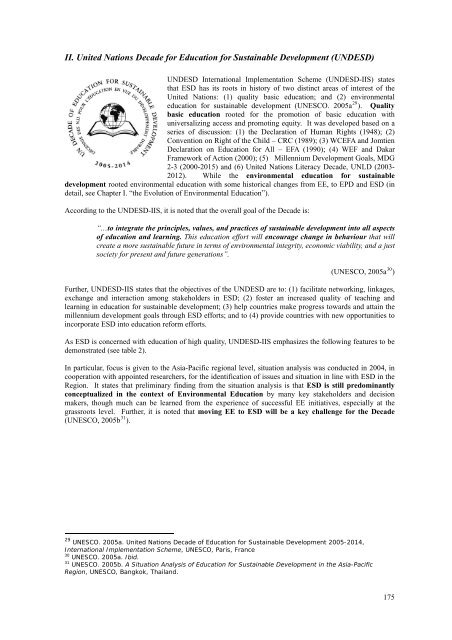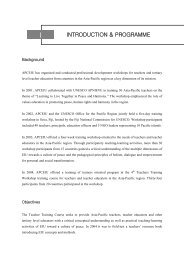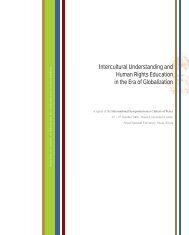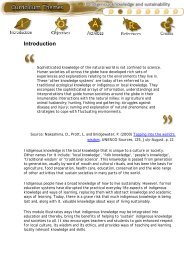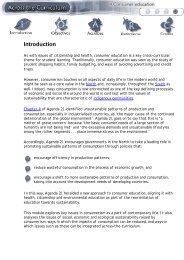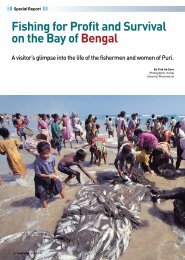REPORT OF UNESCO EXPERT MEETING ON - APCEIU
REPORT OF UNESCO EXPERT MEETING ON - APCEIU
REPORT OF UNESCO EXPERT MEETING ON - APCEIU
Create successful ePaper yourself
Turn your PDF publications into a flip-book with our unique Google optimized e-Paper software.
II. United Nations Decade for Education for Sustainable Development (UNDESD)<br />
UNDESD International Implementation Scheme (UNDESD-IIS) states<br />
that ESD has its roots in history of two distinct areas of interest of the<br />
United Nations: (1) quality basic education; and (2) environmental<br />
education for sustainable development (<strong>UNESCO</strong>. 2005a 29 ). Quality<br />
basic education rooted for the promotion of basic education with<br />
universalizing access and promoting equity. It was developed based on a<br />
series of discussion: (1) the Declaration of Human Rights (1948); (2)<br />
Convention on Right of the Child – CRC (1989); (3) WCEFA and Jomtien<br />
Declaration on Education for All – EFA (1990); (4) WEF and Dakar<br />
Framework of Action (2000); (5) Millennium Development Goals, MDG<br />
2-3 (2000-2015) and (6) United Nations Literacy Decade, UNLD (2003-<br />
2012). While the environmental education for sustainable<br />
development rooted environmental education with some historical changes from EE, to EPD and ESD (in<br />
detail, see Chapter I. “the Evolution of Environmental Education”).<br />
According to the UNDESD-IIS, it is noted that the overall goal of the Decade is:<br />
“…to integrate the principles, values, and practices of sustainable development into all aspects<br />
of education and learning. This education effort will encourage change in behaviour that will<br />
create a more sustainable future in terms of environmental integrity, economic viability, and a just<br />
society for present and future generations”.<br />
(<strong>UNESCO</strong>, 2005a 30 )<br />
Further, UNDESD-IIS states that the objectives of the UNDESD are to: (1) facilitate networking, linkages,<br />
exchange and interaction among stakeholders in ESD; (2) foster an increased quality of teaching and<br />
learning in education for sustainable development; (3) help countries make progress towards and attain the<br />
millennium development goals through ESD efforts; and to (4) provide countries with new opportunities to<br />
incorporate ESD into education reform efforts.<br />
As ESD is concerned with education of high quality, UNDESD-IIS emphasizes the following features to be<br />
demonstrated (see table 2).<br />
In particular, focus is given to the Asia-Pacific regional level, situation analysis was conducted in 2004, in<br />
cooperation with appointed researchers, for the identification of issues and situation in line with ESD in the<br />
Region. It states that preliminary finding from the situation analysis is that ESD is still predominantly<br />
conceptualized in the context of Environmental Education by many key stakeholders and decision<br />
makers, though much can be learned from the experience of successful EE initiatives, especially at the<br />
grassroots level. Further, it is noted that moving EE to ESD will be a key challenge for the Decade<br />
(<strong>UNESCO</strong>, 2005b 31 ).<br />
29 <strong>UNESCO</strong>. 2005a. United Nations Decade of Education for Sustainable Development 2005-2014,<br />
International Implementation Scheme, <strong>UNESCO</strong>, Paris, France<br />
30 <strong>UNESCO</strong>. 2005a. Ibid.<br />
31 <strong>UNESCO</strong>. 2005b. A Situation Analysis of Education for Sustainable Development in the Asia-Pacific<br />
Region, <strong>UNESCO</strong>, Bangkok, Thailand.<br />
175


